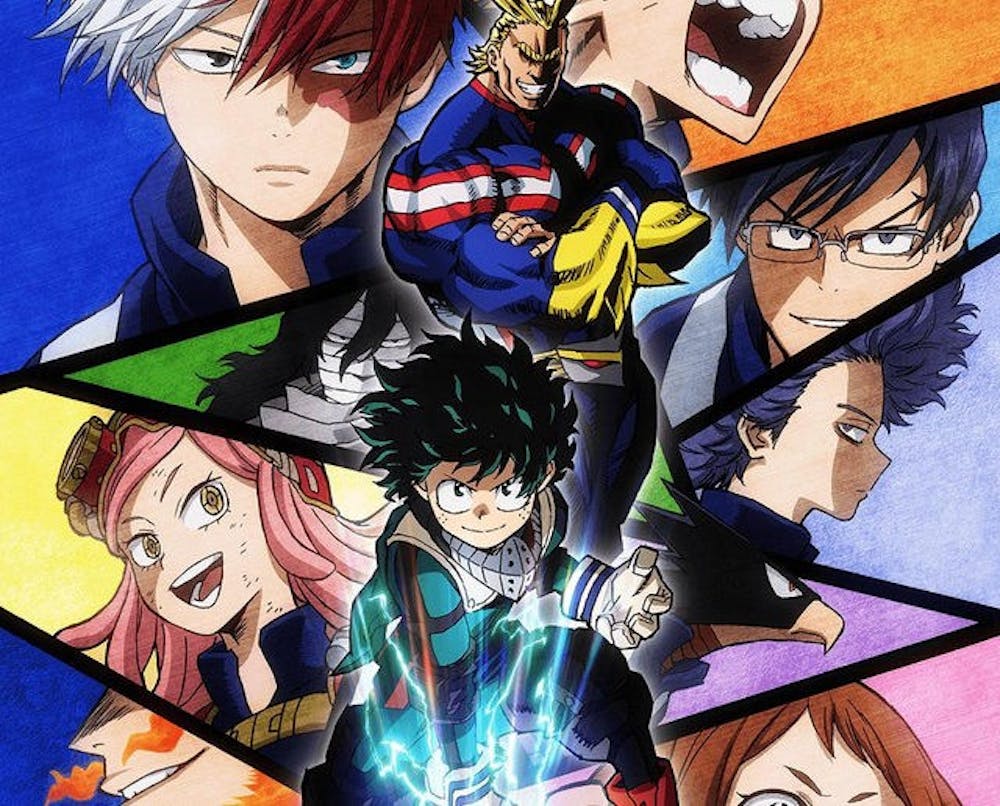Warning: This review contains spoilers for this season and the previous season of My Hero Academia.
The world of My Hero Academia can easily be imagined as what would happen if the Incrediblesheroes failed to beat Syndrome. A vast 80% of the population has a superpower, known as a quirk. However, not everyone is created equally in this society. Some powers are outright ridiculous, such as the ability to make small objects float, while others are insanely overpowered, such as having jet engines implanted within one’s legs. This has caused the world to contain living superheroes, while the 20% without any superpower are shunned.

Image from Funimation
The story of this series follows Izuku Midoriya, a student who lacks any powers. Despite this, Midoriya dreams of becoming All Might, the number 1 ranked superhero in the world. Surprisingly, Midoriya inherits All Might’s powers by proving his determination to want to help others. By gaining these powers, Midoriya is able to get into the best superhero school, UA, and must now train to become the new number 1 superhero.
Fast action, faster plot
In the world of anime, a common misconception is that the second season is always worse than the predecessor. However, season 2 of My Hero Academia proves this assumption to be completely false. Looking back, season 1 of the series was short-lived and provided mostly character introductions. With season 1 containing only a measly 13 episodes compared to this season’s 25, season 2 provides enough plot development to be split into multiple parts.
The season begins promptly with the tournament arch. My Hero’s tournament arch breaks up into three rounds. The first round, an obstacle course race, is very brief and doesn’t provide any character depth. This round feels incredibly redundant because it barely gives any challenge to the many students. Furthermore, this challenge doesn’t show off any new obstacles that haven’t already been established in the series. However, it establishes how the competition plays out in the rest of the tournament. The second round, the cavalry battle, forces the UA students to work together to achieve the most points. Through this forced interaction, the round plays out really well in both showcasing each student’s powers and their abilities to work together. This stage is better because it showcases the different freshmen classes. This second session also opens up the possibility for these underclassmen to be developed later on, which the final round does exploit a little.

Image from YouTube
The final round is a basic one-on-one fight. This round offers amazing background upon why Shoto Todoroki created a rule to never use his father’s quirks, and why he broke that rule for Midoriya. Furthermore, the round showcased immense detail about each student’s quirk, including some of the students from the other classes. This was a nice refresher since the first season never expanded upon the majority of the students’ powers. To top it off, the tournament ended in a way that surprised even myself. This round was an excellent break from the common tradition of having the protagonist win.
Despite these rounds, this arch could have been improved by showcasing some of the upperclassmen tournament rounds. By displaying these matches, the series could have shown how much training the freshman class still had to go through in order to become pros. Despite this lack of depth, the series maintains a fast-paced motion that never stops. Each episode portrays a meaning and development to multiple characters and narratives that still entertains in quirky ways.
Stain enters the fray
This fast momentum is continued with the second major section of the show, which is the Hero Killer arch. This part starts with the freshmen students choosing their hero names and picking a pro hero to intern with. While many of these internships are pointless for many students, there is primarily development through Midoriya, Uraraka, Asui, and Iida. While Midoriya still reaches new heights with All For One, the narrative actually switches to Iida. This is due to the new villain, Hero Killer Stain, who specifically kills pro heroes quickly and mercilessly. Iida’s brother gets injured by the Hero Killer, and Iida undergoes a major change for revenge against this crime.

Image from iTech Post
This change in Iida’s behavior proves that even the most stagnant characters can experience the most dramatic change. This is also evident in Uraraka and Asui, with the former working on her lack of fighting skills and the latter working on a potential field of work. The Hero Killer aspect of the arch wraps up quickly through one of the best fights in the series between the villain and the team of Midoriya, Shoto, and Iida. Furthermore, this arch improves the series by providing a layout for the proposed major conflict of the series.
Finer detail, greater emotion
Throughout the season, the sheer amount of episodes seems rather daunting from an animation and production standpoint. However, the detail of the shading and the amount of effort for each character still shines through. The use of lighting can change how the students can view All Might or showcase how the flames flurry off of Shoto. Even with these achievements, the soundtrack does suffer a little. Even though the openings and endings are a story unto themselves, the underlying track does get a tad repetitive due to overuse.
What the future holds
The season ends rather abruptly with the students facing off against their teachers, and this conclusion feels redundant. While the fights are fantastically animated and humorous, they merely showcase what the internships already taught the students. However, the conclusion does manage to unveil some major plot points. This plot is presented cleanly by showcasing that every superhero has a flaw. Through the exposure of All Might’s true faults and the evolving villain organization, the series has set itself up perfectly for the next season.

Featured image from Crunchyroll
For more entertainment related content, visit us at Byte Bsu!




















